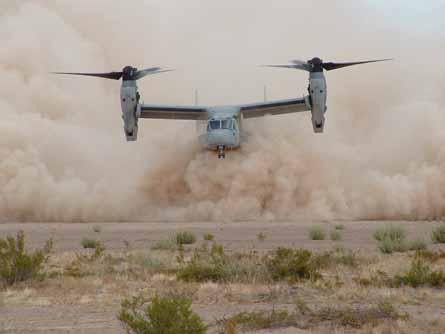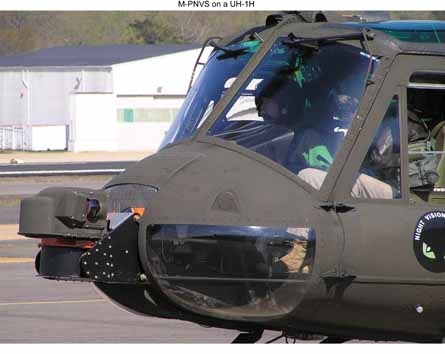As it approaches the ground, dust blown up by the rotor envelops the helicopter, obscuring the pilot's view of the landing zone. Unable to see the ground, the pilot becomes disoriented and the aircraft begins to drift dangerously. This is brownout.
| |
|---|
BAE Systems is developing a an all-weather cable and detection |
Helicopter shoot-downs make headlines, but brownout is among the biggest hazards to rotary-wing operations in Iraq and Afghanistan, where it is blamed for three-quarters of coalition helicopter mishaps. Another is collision with poles and wires, some strung deliberately by insurgents.
The military and industry are pursuing several potential solutions to the twin problems of operating in degraded visibility and detecting and avoiding obstacles. Most involve a sensor and a display, but the challenge is to find a solution that can be retrofitted rapidly and affordably across a large fleet of different rotorcraft types without adding too much weight to the aircraft and workload on the pilots.
The US Defense Advanced Research Projects Agency (DARPA) has taken the lead in tackling brownout with an 18-month programme called Sandblaster. Under a $16.5 million contract awarded in April, Sikorsky is to demonstrate an integrated solution for operating in degraded visibility - primarily brownout, but also rain, fog and whiteout caused by rotor-blown snow.
| |
|---|
Dust thrown up by rotors can cause pilot disorientation |
"Sikorsky has been working for a number of years on various pieces of a brownout solution. But it is a system integration problem that requires an integrated solution," says Russ Gray, chief engineer, advanced programmes. "A number of different companies are working on a sensor - infrared, radar, laser, even acoustic - but that is just one piece of the overall solution."
Gray says Sandblaster is an effort to address the brownout problem "head-on and once and for all after years of chipping away at it". It is an usual programme for DARPA in that the end result is to be a full system ready for operational deployment.
Brownout occurs when the rotor downwash of an approaching helicopter stirs up dust and sand. The problem is most acute below 50ft (15m) altitude, as the helicopter slows to hover or land and the rotor starts to recirculate the dust. The pilot loses visual reference to a fixed point on the ground and the aircraft begins to drift away from its intended approach path. Landing with drift can cause the helicopter to roll over on touchdown.
Sandblaster is intended to provide a visual picture of the approach path and touchdown point, cueing commands to maintain stabilised flight, and reduced workload to stay on the flightpath. Sikorsky's approach integrates three pieces, Gray says: see-through sensor, synthetic-vision display and advanced flight-control modes.
The helicopter manufacturer is teamed with Sierra Nevada, providing the 94GHz millimetre-wave radar sensor, and Honeywell, providing the synthetic-vision display and sensor fusion. Sikorsky is developing automatic flight-control modes to assist the pilots.
The approach will be flown using synthetic perspective imagery on a head-down multifunction display (MFD), generated from onboard terrain and obstacle databases and augmented with an "evidence grid" produced using imagery from the fixed forward-looking radar. "We fuse the real-time sensor data into the synthetic view of the world. The radar provides a real-world basis for the synthetic environment," Gray says.
Critical sensor
"If the pilot is flying in a purely synthetic world there are real things he can run into. The sensor detects these," he says, adding: "As the helicopter approaches the ground the real-time sensor becomes critical."
New flight control modes will provide predictive guidance and augmented aircraft response. "If the pilot becomes disoriented, the flight controls keep the aircraft level and on a path to the landing point," says Gray. "An automated hover hold will allow the pilot to stop and look around - to regroup and not rush. The flight controls will take the workload out of the situation."
Sandblaster is divided into three six-month phases - component fabrication, integration and evaluation - and is planned to end in September next year. The final six months will involve sensor tests on a dust range in Arizona, and integrated system evaluations in Sikorsky and NASA rotorcraft simulators and flight tests in RASCAL, the NASA/US Army UH-60 flying laboratory.
The target platform for Sandblaster is the army's Sikorsky UH-60M, but the open system architecture is sensor- and display-independent. "We need to keep it lightweight and low cost so it can fit on as many aircraft as possible," says Gray. "We will be able to display on any existing MFD."
Other agencies are working on partial solutions to brownout. In February, the US Air Force Research Laboratory flight tested a prototype Photographic Landing Augmentation System for Helicopters on an Air Force Special Operations Command Sikorsky MH-53. PhLASH is a "see and remember" system that uses an electro-optical sensor and infrared strobe lights to photograph the landing zone on final approach and geo-register the images with a point on the ground before the helicopter enters brownout conditions.
The system captures a series of high-resolution still images of the landing area and nearby obstacles and transforms these in real time into a video-like display based on the subsequent flightpath of the helicopter. AFRL, which worked with Applied Minds to develop the PhLASH prototype, has been funded to develop a ruggedised system suitable for permanent installation on AFSOC rotorcraft.
The PhLASH display will not reflect changes to the landing zone, including something that moves into the helicopter's path, in the 20s or so between taking the last picture and touching down, and Sikorsky does not see the system as a total solution to brownout. "See-and-remember systems like PhLASH and others need to get a clear view of the landing zone to get a snapshot to use for landing. This is not possible if aircraft are landing one after the other," says Gray.
The first helicopter to arrive stirs up the dust, obscuring the landing zone for those that follow. "It works with one helicopter that is alone, but you can't get multiple aircraft into a landing zone without real-time data," he says.
Lockheed Martin proposes tackling the brownout and obstacle avoidance issues simultaneously with a version of its pilot night vision system for the Boeing AH-64D Apache Longbow, modified for use on cargo and utility helicopters. Now in company-funded development, the Pathfinder pilotage system is being promoted as a better solution to overcoming brownout and avoiding obstacles than using existing forward-looking infrared targeting sensors.
"It does not make sense to use a targeting sensor on a cargo aircraft when the mission is pilotage," says Monty Watson, deputy programme manager, Apache fire control. The Pathfinder comprises a long-wavelength infrared (LWIR) sensor turret coupled to a head-tracked helmet-mounted display.
| |
|---|
The Pathfinder's sensor turret is coupled to a helmet mounted display |
"Previously only targeting FLIRs were available. We are trying to focus attention on the availability of a pilotage FLIR that is more suited to cargo aircraft," says Watson. "Pathfinder is the only sensor that supports 'head-up, eyes-out' pilotage. The wide field of view maximises situational awareness, and LWIR outperforms other electro-optical/infrared sensors in brownout."
The Pathfinder has a 1,728 x 960-pixel resolution and 52 x 30° field of view, compared with 640 x 480-pixel and 25 x 20° for a targeting FLIR. "You need longwave for pilotage. If you use a mid-wave targeting sensor for pilotage you have to blow up the image to get the field of view and you lose resolution," says Watson. Mid-wave images will also blur if the pilot moves his head too fast, he says. The system displays infrared imagery integrated with flight symbology, and Lockheed is working with two suppliers of high-definition visor-projected helmet displays: Rockwell Collins and Thales.
Under a co-operative research and development agreement with the US Army's Night Vision Laboratory, Lockheed is demonstrating the concept by flying an Apache sensor and helmet on a Bell UH-1H. Watson says the company will be ready to integrate a Pathfinder production prototype onto a cargo or utility helicopter in August and is trying to secure an agreement "for a full operational evaluation" on a US Army UH-60 or Boeing CH-46.
"Pathfinder supports brownout, but opens up other mission areas. It is not suboptimised just for brownout," says Watson. He says Lockheed offered DARPA use of the UH-1 testbed for Sandblaster, as a benchmark against which to compare other technologies, "but they said no thank you".
Different obstacles
While brownout is the primary focus of Sandblaster, the Sikorsky team has to keep other degraded visual environments, like whiteout, in mind, says Gray. The system will also be evaluated against a variety of different ground obstacles, including cables, which the sensor "should be able to see", he says.
BAE Systems is developing an all-weather cable and obstacle detection system that also uses a 94GHz millimetre-wave radar sensor. The system combines the active radar with a passive terrain database - BAE's Terprom - to detect and warn of both mapped and unmapped obstacles. The modular system can also use an adapted radar altimeter, with BAE having found that radalt returns can be processed to detect certain obstacles.
A prototype of the radar cable detection system has been flight tested and Terprom is in service, but the two have not yet flown together. "Perhaps next year," says BAE. The radar, a modified missile seeker, looks ahead along the helicopter's flight path. If a wire is detected, a warning flashes on the flight display, and the pilot's controls vibrate, until the helicopter is steered away from the obstacle. A later version of the radar could be used to image the landing zone through obscurants, BAE says.
While these and other government- and industry-funded efforts to tackle the dual hazards of brownout and obstacles continue, and helicopter crews in Afghanistan and Iraq daily face the operating challenges, Sikorsky's Gray believes the US Army "is not rushing to a DVE solution - they are looking to Sandblaster for an integrated solution".
Source: Flight International



















